Toshiba Excite 7.7 Tablet Review: AMOLED in a Fun Size
by Dustin Sklavos on August 29, 2012 2:01 PM ESTDisplay
Evaluating the Toshiba Excite 7.7's display has turned out to be more difficult than anticipated, due in no small part to the AMOLED panel used. That difficulty is exacerbated by what Toshiba calls their "AutoBrite" technology. This is a fundamental issue that has been brought up in other reviews of the Excite 7.7 that I've read, and it could very easily be a dealbreaker.
Depending on what's displayed on the Excite 7.7, the screen will dynamically brighten or dim. This isn't the usual ambient light sensor brightness control, this has to do with the content itself, and unfortunately it can get distracting. I suspect it's an "extra mile" to try and optimize what's already a beautiful AMOLED display, but in practice even scrolling through a Facebook page can become slightly annoying when the display pops up a bit, then dims a bit depending on how much white is on what you're looking at. If you're looking at content that's a bit more contrasty and tends towards darker hues more, the display becomes brighter to compensate.
There is no way that I can find to turn this off.

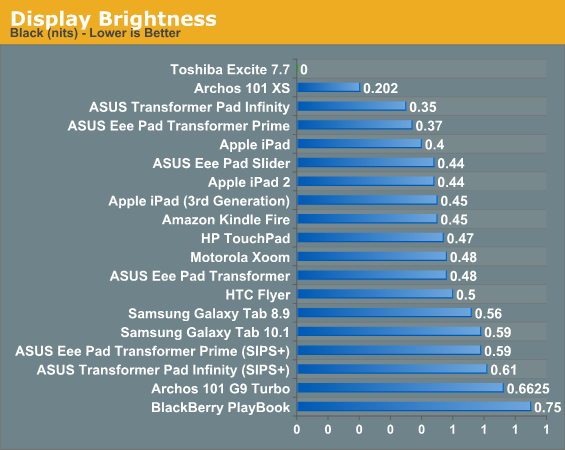
The black level is bulletproof, but I'm ambivalent on the white level. I measured it with the same hardware I use to measure notebook displays, but 175 nits seems extremely low and that's only exacerbated by Toshiba's own dynamic brightness modulation. When I look at the display, it's definitely not 175 nits; eyeballing it I'd say maximum brightness is easily past 300 nits.
With all that said, it's hard not to be wowed by the display. AMOLED technology produces the deepest blacks you're going to get in any kind of portable display, and the colors are equally vibrant and impressive. Even with the brightness adjustments going on, I personally think it's still more desirable than even an IPS display, but your mileage may vary.
Performance
NVIDIA's Tegra 3's performance is already pretty much a known quantity, but it's still impressive to see Tegra 3 stretching its legs in a tablet this small.
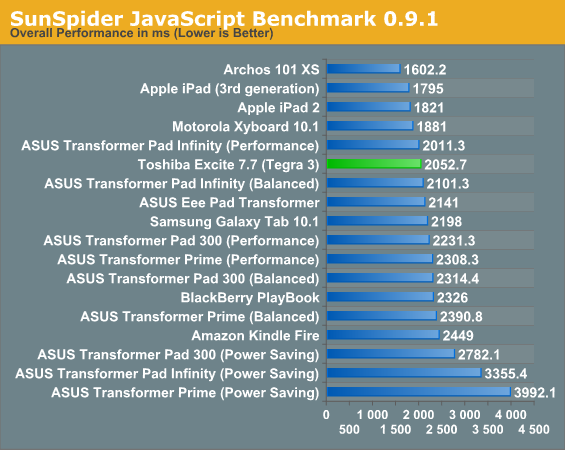
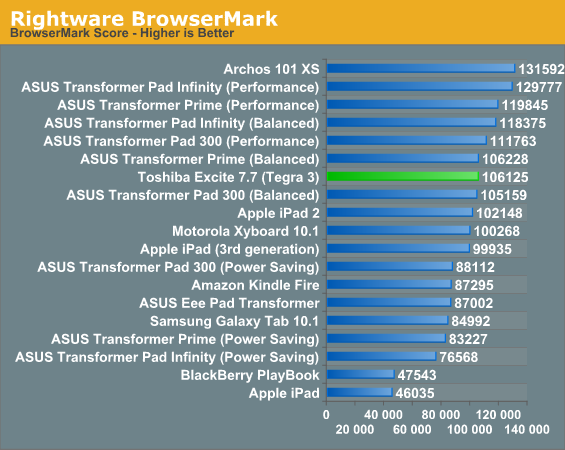
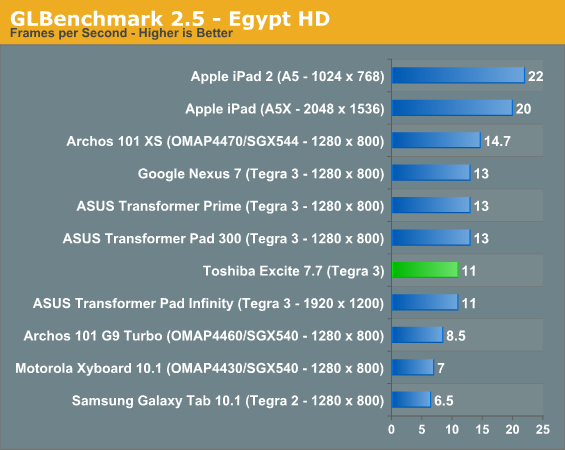
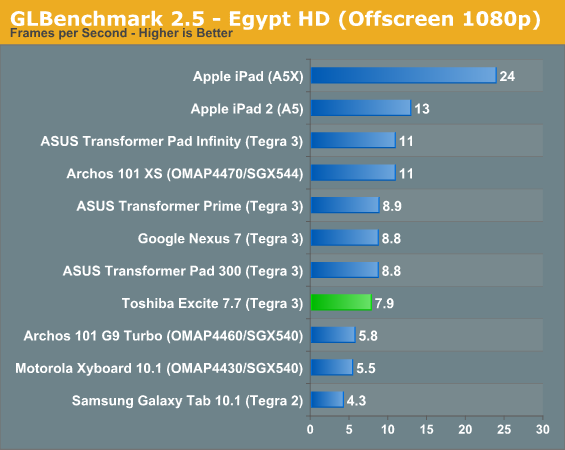

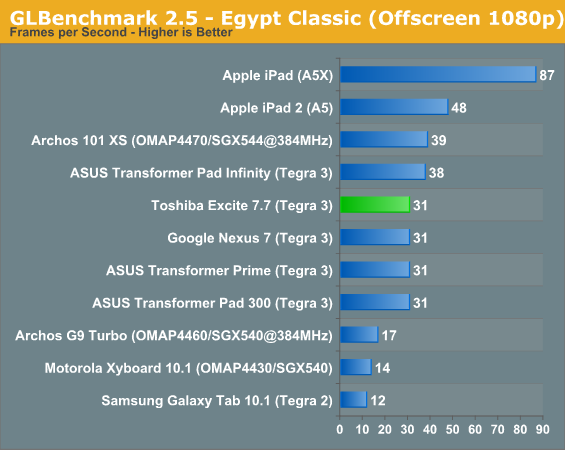
Performance isn't out of the park, but it's definitely competitive with other, larger tablets. You're definitely not making any sacrifices for the form factor here, the Excite 7.7's about as fast as any other Tegra 3-powered tablet out there.










50 Comments
View All Comments
EnzoFX - Wednesday, August 29, 2012 - link
Why do these amoled screens look so overly saturated? Maybe I just need to see some in person, but I would imagine it would handle everything on the image equally, too saturated. How can this remain consistent with someone that uses calibrated displays?Jaybus - Thursday, August 30, 2012 - link
I'm not so sure that it is the OLED display that is too saturated. The content itself is designed for maximum brightness to compensate for the poor contrast of LCD, and this likely makes it look too saturated on OLED.I would imagine the dynamic control is not so much for keeping power draw down as it is for adjusting to ambient lighting conditions. OLEDs are brighter and have a far greater dynamic range. Take them side by side out into direct sunlight and it will be obvious. The OLED will draw more power and be visible. The LCD will simply not be visible.
guidryp - Thursday, August 30, 2012 - link
Displaymate tests back up what you are seeing. There is measurable oversaturation on many OLEDs, do to non standard wider gamuts, or just plain overboosted color.Both are likely on purpose to give the impression that OLED has more vivid colors.
I prefer accuracy and standard gamuts, so colors look realistic.
Romberry - Wednesday, August 29, 2012 - link
You wrote "The only breakthroughs in this market seem to have been ASUS with their Transformers and Amazon's Kindle Fire..." In response, I have to ask if the Google (Asus) Nexus 7 slipped your mind? Various outlets are reporting that sales figures for the Nexus 7 (which in my opinion is a very good tablet and a great value for the price) are expected to be as high as 8 million units. For a device that wasn't even introduced until mid-year, that seems pretty dang respectable and I'd have to call it a market breakthrough. Sure broke through to me.bplewis24 - Wednesday, August 29, 2012 - link
$8MM seems awfully high. I have one and so does my brother, but still I would be surprised with that number. Any sources for that?bplewis24 - Wednesday, August 29, 2012 - link
Never mind, I read some of the articles. I didn't realize the 8MM was through year-end 2012. I thought you were saying it was to-date. Still, 8 million is impressive.Souka - Wednesday, August 29, 2012 - link
$499 for a 7.7 tablet?And I like how the Nexus 7 (which is $199) is left out of most of the discussion and hardware comparisions.
But ohhhh... glad the Kindle Fire is included... an old outdated tablet.
nathanddrews - Wednesday, August 29, 2012 - link
The review lost me at "$499".Bonesdad - Wednesday, August 29, 2012 - link
I had the exact same thoughts. Why wasn't this compared to the Nexus 7? They are most similar and Nexus is arguably at the top of the 7" tablet heap right now. And the Kindle Fire? When the new Kindle Fire is announced next week, I hope you will include this Toshiba and the Nexus 7 as comparisons.No way am I dropping $500 on a 7 inch tablet. This unit is DOA for that reason alone. I was hoping it would be competitive at least.
nerd1 - Wednesday, August 29, 2012 - link
Wonder why the writer didn't include GT 7.7 with 7.7" SAMOLED.